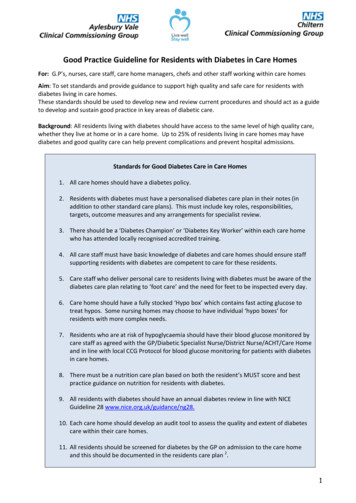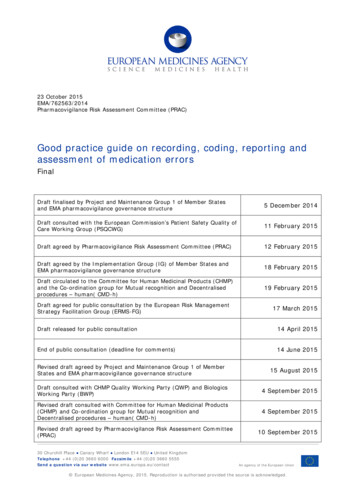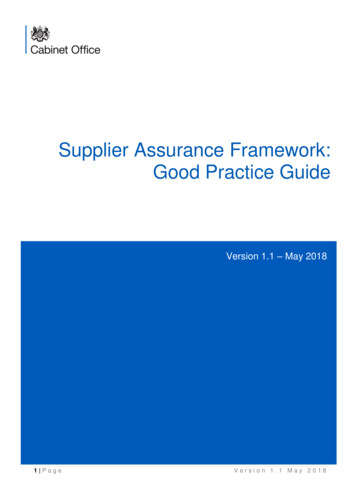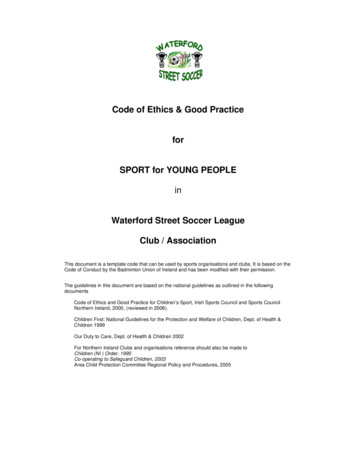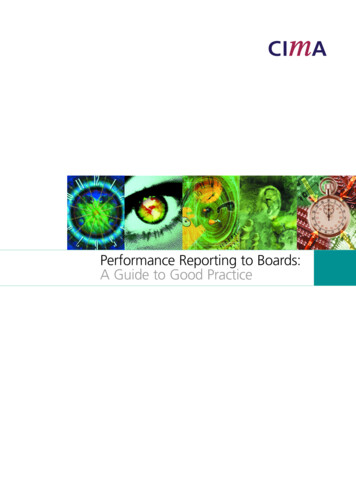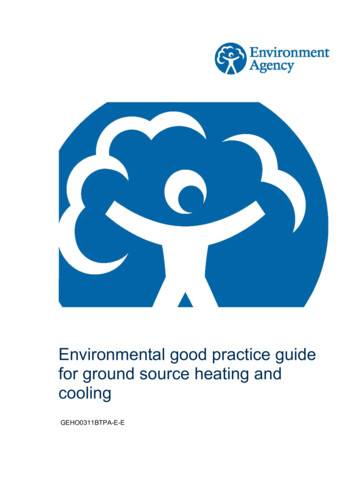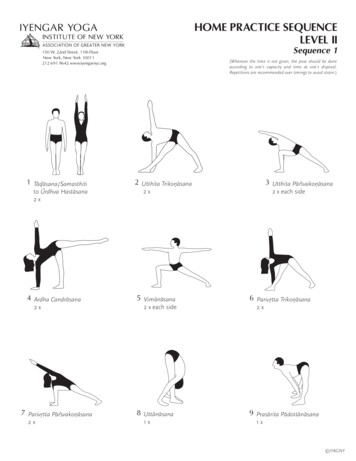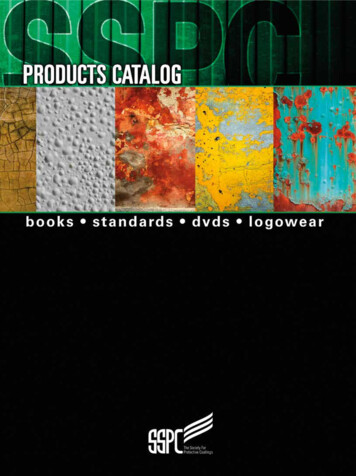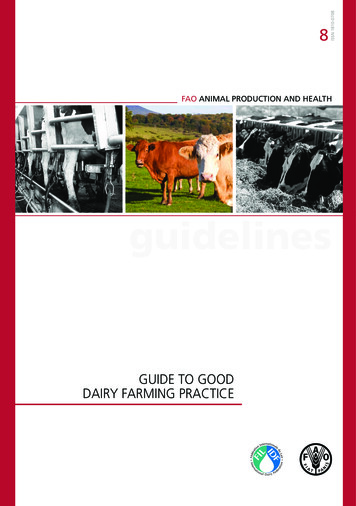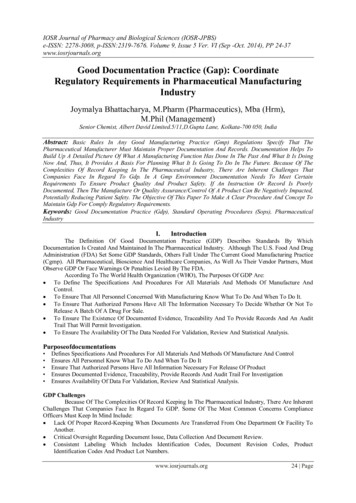
Transcription
IOSR Journal of Pharmacy and Biological Sciences (IOSR-JPBS)e-ISSN: 2278-3008, p-ISSN:2319-7676. Volume 9, Issue 5 Ver. VI (Sep -Oct. 2014), PP 24-37www.iosrjournals.orgGood Documentation Practice (Gap): CoordinateRegulatory Requirements in Pharmaceutical ManufacturingIndustryJoymalya Bhattacharya, M.Pharm (Pharmaceutics), Mba (Hrm),M.Phil (Management)Senior Chemist, Albert David Limited.5/11,D.Gupta Lane, Kolkata-700 050, IndiaAbstract: Basic Rules In Any Good Manufacturing Practice (Gmp) Regulations Specify That ThePharmaceutical Manufacturer Must Maintain Proper Documentation And Records. Documentation Helps ToBuild Up A Detailed Picture Of What A Manufacturing Function Has Done In The Past And What It Is DoingNow And, Thus, It Provides A Basis For Planning What It Is Going To Do In The Future. Because Of TheComplexities Of Record Keeping In The Pharmaceutical Industry, There Are Inherent Challenges ThatCompanies Face In Regard To Gdp. In A Gmp Environment Documentation Needs To Meet CertainRequirements To Ensure Product Quality And Product Safety. If An Instruction Or Record Is PoorlyDocumented, Then The Manufacture Or Quality Assurance/Control Of A Product Can Be Negatively Impacted,Potentially Reducing Patient Safety. The Objective Of This Paper To Make A Clear Procedure And Concept ToMaintain Gdp For Comply Regulatory Requirements.Keywords: Good Documentation Practice (Gdp), Standard Operating Procedures (Sops), PharmaceuticalIndustryI.IntroductionThe Definition Of Good Documentation Practice (GDP) Describes Standards By WhichDocumentation Is Created And Maintained In The Pharmaceutical Industry. Although The U.S. Food And DrugAdministration (FDA) Set Some GDP Standards, Others Fall Under The Current Good Manufacturing Practice(Cgmp). All Pharmaceutical, Bioscience And Healthcare Companies, As Well As Their Vendor Partners, MustObserve GDP Or Face Warnings Or Penalties Levied By The FDA.According To The World Health Organization (WHO), The Purposes Of GDP Are: To Define The Specifications And Procedures For All Materials And Methods Of Manufacture AndControl. To Ensure That All Personnel Concerned With Manufacturing Know What To Do And When To Do It. To Ensure That Authorized Persons Have All The Information Necessary To Decide Whether Or Not ToRelease A Batch Of A Drug For Sale. To Ensure The Existence Of Documented Evidence, Traceability And To Provide Records And An AuditTrail That Will Permit Investigation. To Ensure The Availability Of The Data Needed For Validation, Review And Statistical Analysis.Purposeofdocumentations Defines Specifications And Procedures For All Materials And Methods Of Manufacture And ControlEnsures All Personnel Know What To Do And When To Do ItEnsure That Authorized Persons Have All Information Necessary For Release Of ProductEnsures Documented Evidence, Traceability, Provide Records And Audit Trail For InvestigationEnsures Availability Of Data For Validation, Review And Statistical Analysis.GDP ChallengesBecause Of The Complexities Of Record Keeping In The Pharmaceutical Industry, There Are InherentChallenges That Companies Face In Regard To GDP. Some Of The Most Common Concerns ComplianceOfficers Must Keep In Mind Include: Lack Of Proper Record-Keeping When Documents Are Transferred From One Department Or Facility ToAnother. Critical Oversight Regarding Document Issue, Data Collection And Document Review. Consistent Labeling Which Includes Identification Codes, Document Revision Codes, ProductIdentification Codes And Product Lot Numbers.www.iosrjournals.org24 Page
Good Documentation Practice (GDP): Coordinate Regulatory Requirements In Pharmaceutical . Ensuring Proper Security And Storage Of Documents During Review Process.Proper And Consistent Identification Of All Documents Through All Processes.Ensuring That All Those Whose Signatures Appear On The Documents Understand Why They Signed TheDocuments As Well As Any And All Responsibilities Associated With The Signing Of The Documents.II.Key Qualities Of Regulated Documents As Per GdpKey Qualities of Regulated Documents: Concise: Present Information Clearly So It Can Be Easily Understood With No Room ForMisinterpretation. For Example, The Date Format “05/06/12” Can Cause Confusion. Use One That IsUnambiguous, Such As “05 Jun 2012.” Legible: Information Should Be Readable And Leave No Room For Error (For Example, Hand-WrittenData That Are Not Legible May Cloud Data Analysis Or Result In “Missing Data”). Accurate: Documentation Should Be Error-Free―Properly Reviewed, Verified And Approved.Information Should Be Recorded As An Event Happens And Not After The Fact, So As To AvoidRecording “What You Remember” Rather Than “What Actually Happened.” Traceable: Documentation Should Be Traceable. Make It Clear Who Logged The Information, What ItWas, And When And Why It Was Documented. 1Do’s and Don’ts with Document Use Black Or Blue Permanent, Indelible Ink. Make Clear, Complete And Legible Entries. Make An Entry When An Event Happens (Not Later). Make Corrections That Are Legible And Traceable. For Example, When A Correction Is Required, Put ALine Through The Error, Make The Correction Next To The Error, Include An Explanation (If It Is NotSelf-Explanatory), And Initial And Date The Correction. If It Is Not Appropriate To Fill In A Space In A Document (Such As An Empty Page), Enter “N/A,” YourInitials And The Date So That No Further Information Can Be Added Later. Follow Established Standard Operating Procedures (Sops)―For Example, Document Review AndApproval Processes, Version Control, And Date And Time Formats, As Well As Record Retention, ChangeControl, Electronic Signature (If Applicable) And So On. Provide Training To Everyone In Company. Do Not Use Pencils Or Erasable Ink. Do Not Use “Write-Out” Or Any Masking Devices. Do Not Make Corrections That Are Not Traceable (For Example, Overwriting Entries With No Date, InitialOr Explanation). Do Not Use “Sticky” Notes. Do Not Back-Date Or Post-Date. Do Not Use Ditto Marks. Do Not Use Asterisks That May Cause Confusion (Such As Using The Same Asterisk For DifferentFootnotes). Do Not Transcribe Data. Do Not Use Unbound Laboratory Notebooks Without Page Numbers (That Is, Avoid Any DoubtConcerning Missing Pages).III.Classification Of DocumentationFollowing Are The Classification Of Documents For Organization & Personnel.For Buildings & FacilitiesFor Equipments.For Handling Of R.M.& P.M.For Production & Process Control.For Packaging & Labeling Control.For Holding & DistributionFor Laboratory Control.For Records & Reports.For Return & Salvaged Finished Products.www.iosrjournals.org25 Page
Good Documentation Practice (GDP): Coordinate Regulatory Requirements In Pharmaceutical .Type Of Documents Used In PharmaceuticalsSpecifications: As Per MHRA Specifications Describe In Detail The Requirements With Which TheProducts Or Materials Used Or Obtained During Manufacture Have To Conform. They Serve As A Basis ForQuality Evaluation. We Need Specification For:1.2.3.4.Active And Inactive MaterialsPrimary Printed And Packing MaterialsIntermediate And Semi Finished ProductFinished ProductSops: It Is A Written, Authorized Functional Instruction Used As A Reference By The Person Responsible ForPerformance And Are Also Used For Training New Operators In The Performance Of The Procedure. Test Method: It Is A Written And Approved Documents Describe The Detailed Testing Procedure. List: Documents Contain A Catalog Of Any Object Such As List Of Equipments. Certificates Of Analysis: It Is An Authentic Documents Shows The Analytical Reports And Decision OfAcceptance/Rejections Label Records Organ Gram Job Description Batch Manufacturing Records: It Is An Important Document Issued For Every Batch Of Product To Assure,Review And Record Keeping Of Any Product Batch. There Are Following Major Content Of BMR.1. Name Of Product, Generic Name, Strength, Shelf Life, Manufacturing Date And Exp Date.2. A Complete List Of Ingredients With Full Description, Codes And Quantity To Be Issued.3. A Statement For Theoretical Yield And Reconciliation.4. A Complete MFG And Control Instructions, Sampling And Testing Procedure, Specification And PrecautionTo Be Followed.5. A Statement For Processing Location And Equipment.6. The Method Or Reference To Method To Be Used For Preparing The Critical Equipment Including Cleaning,Assembling, Calibrating And Sterilizing.7. Dates And Time Of All Activities8. Line Clearance Procedure In Every Steps9. Labeling Control And Specimen For Coding In Primary, Secondary And Tertiary Packing Materials10. Deviation Record11. Result Of Examine Made.Site Master File: It Is A Document, Which Provides All Information Of A Pharmaceutical Plant. There AreFollowings Content To Be Needed To Prepare A SMF.1. General Information, It Includes Information Related To Organization, Mfg Activities, Name And Address,Type Of Products Description Of Site Employee Details External Technical Support, Quality ManagementSystem.2. Personnel, Organizational Chart, Qualification, Experience And Responsibilities Of Key Personnel Training ,Health Requirements And Personnel Hygiene Clothing3. Premises And Equipments: Description Of Manufacturing Area , Nature Of Construction And Finish, BriefDescription Of Ventilation, Special Areas, Water System, Maintenance Of Premises, Major Production AndLaboratory Equipments, Maintenances Of Equipments, Calibrations And Sanitizations.4. Documents, Preparations, Revision And Distributions Of Documents,5. Production, Brief Description Of Production Operations, Handling Of Materials, Handling Of RejectedMaterials And Product, Brief Description Of General Policy Of Process Validation.6. Quality Control, Quality Management System7. Self Inspection, Self Inspection Program.8. Change Control, It Is A Document For Review, Approval And Implementation Of Any Change In ValidatedSystem, Equipment, Process And Materials Etc.9. Protocols: A Written Plan Stating How Validation Will Be Conducted And Defining Acceptance Criteria. ForExample, The Protocol For A Manufacturing Process Identifies Processing Equipment, Critical ProcessParameters/Operating Ranges, Product Characteristics, Sampling, Test Data To Be Collected, Number OfValidation Runs, And Acceptable Test Results.www.iosrjournals.org26 Page
Good Documentation Practice (GDP): Coordinate Regulatory Requirements In Pharmaceutical .Preparation, Issues And Uses Of DocumentsDocuments Should Be Carefully And Logically Specify To Prevent Wrong Uses. All Necessary Information‟sAre Written Unambiguously. Each Document Includes:1.Company Name2.Purpose And Title Of Documents3.Identification No And Revision No.4.Date Of Authorization5.Date Of Review6.Signature Of Prepared By, Checked And Authorized By.7.Distribution List8.Page No.9.Reason For Revision Should Be Documented.10. Abbreviation And ReferenceEach Document Is Clear And Computerized So That It Is Readable, Issued Documents Signed By A ConcernPerson To Indicate A Verified Issue. Any Correction Is Made By Cutting With Single Line With Signature AndDate, Do Not Overwrite. Document To Filled Have A Sufficient Space, Ball Ink Pen Should Be Used For HandWritten Filling.IV.Steps Involved In GdpHierarchical Document System:The Regulations That A Company Is Responsible For Following (E.G., USFDA/EUGMP/ICH/Schedule M, Etc.) Should Be At The Top Of The Document Pyramid And Should Govern TheDirectives Of The Sublevels.The Level Immediately Beneath The Regulations, Level 1 Documents (E.G., The Quality Manual),Should Break The Regulations Into Parts Specific To Those That The Company Is Required To Follow. TheseDocuments Should Establish Overall Principles And Guidelines For How The Company Plans On Developing,Documenting, And Implementing A Ccmp-Compliant Quality System. Top-Level Documents Apply To AllDepartments Within A Cgmp-Compliant Company And Are Not Specific In Nature.The Next Level, Level 2, Of Documents In The Hierarchical Document Pyramid Should Further BreakDown The Parts Of The Regulations Into Specific Subjects Or Topics. These Documents (E.G., CompanyPolices) Should Establish Guidelines With Which All Subordinate Level Procedures Must Comply To EnsureConsistency Across Departments.Level 2 Documents Should Not Provide Specific Directive Instructions Or Forms For DocumentingData But Rather Provide The Overall Intentions And Guidelines Governing Critical Programs Or Systems AsWell As Explanation For The Rationale And Program Designs. These Documents Will Apply To AllDepartments Within A GMP-Compliant Company.Sops Should Be The Next Level In The Document Hierarchy After Company Policy Documents. TheseTypes Of Documents Should Provide Specific Step-By-Step Instructions For Performing The Operational TasksOr Activities That Were Talked About In The Previous Levels (For Example: SOP Titled ‟Writing, Revising,Numbering, And Distributing Controlled Documents‟). Level 3 Documents (I.E., Sops) Should Be DepartmentSpecific Or Function Specific.The Last Level Of Documents In A Document Hierarchical Structure Are Level 4 Documents. TheseDocuments Are The Most Specific In Nature, (E.G., Batch Record, Test Methods, Validation Procedures). TheyApply To A Specific Department, Product, Equipment, Or Process. Level 4 Documents Provide Step-By-StepInstructions For Production-Related Tasks And Activities As Well As Provide A Means For Documenting SuchTasks Using, For Example, Data Sheets, Forms, Or Batch Records. The Details Outlined In These DocumentsMay Override Directions Given In Other Level Documents. (For Example: The Company‟s DocumentationSOP May State That Numbers Be Rounded Off To Three Significant Figures; The Batch Record, On The OtherHand, May State That All Numbers Be Expressed In Scientific Notation. Thus, Instructions In Level 4Documents, Which Are Specific To A Particular Process, Can Overrule The Instruction Mentioned In Level 3Documents, Which Are General In Nature. The Document Hierarchy Pyramid Is One Way Of Organizing ACompany‟s Documents.GDP Steps: Initial/DateAll Entries To A Cgmp Document Must Be Accompanied By The Identity Of The Person (Initials OrSignature) And The Date That The Entry Was Made. This Is Required By The Code Of Federal Regulations(Cfrs) And Serves As A Tracking Method To Determine That A Task Was Indeed Performed And Who Did TheWork.www.iosrjournals.org27 Page
Good Documentation Practice (GDP): Coordinate Regulatory Requirements In Pharmaceutical .Initials Are The Accepted Standard Method Of Identification. However, Some Operations Require A Signature.For Example, An “Approved By” Space Must Be Filled With A Signature, Not Initials.For Larger Companies With People That Have The Same Initials You Will Need To Make A Standard.Examples Of Your Signature And Initials Will Also Be Recorded By The Various Companies. Recording TimeMilitary Time: Two (2) Digits To Indicate The Hour (00 To 23) Followed By Two (2) Digits To Indicate EhMinutes (00 To 59) Example 0850 And 1750Meridian Time: One Or Two Digits To Indicate The Hour (1 Or 12) Followed By Two Digits To Indicate TheMinutes (00 To 59) Then The Morning (AM) Or Afternoon (PM) Designation. Example 8:50am Or 5:50pm(Notice That It Is The Same As The Above)Your Company Will Probably Have A Standard That They Accept; You Will Need To Inquire As To What ThatIs. Corrections:No Handwritten Changes Or Corrections Will Be Made To The Printed Text Of An Approved Cgmp Document.Consult With Your Supervisor If You Discover An Error. Any Changes Required To An Approved CgmpDocuments Shall Be Implemented Through The Established Quality System.When Making A Correction To A Manually Recorded Entry On A Controlled Document Performs TheFollowing Steps:1. Place A Single Line Through The Incorrect Entry2. Initial And Date The Adjacent To The Cross-Out3. Enter The Correct Data Near The Original Entry4. The Mistake Must Still Be Legible Through The Cross-Out.5. Date Of The Correction Is The Date The Correction Was Made, Not The Date The Error Was Made. Performed ByPerformance Of A Stip Must Be Documented At The Time Of Completing The Stip And Prior To MovingOn To The Next Stop. Do Not Execute A Stip If The Manufacturing Procedure Is Not Available ForDocumenting Necessary Data At The Time Of Execution. The Following Personnel May Initial And Date The“Performed By” Space1. Personnel Already Proficient In The Task Performed, Or2. Personnel Who Are In Training Under The Supervision Of Their Qualified Trainer Recorded ByThe “Recorded By” Space Is Used If The Operator Performing The Operation Is Unable To Initial AndDate Immediately, Due To Working In A Confined Or Restricted Space, Such As A Laminar Air Flow Hood.This Situation Is The Only Exception To The “Performed By” Rule. Data Must Then Be Recorded By AnotherPerson Watching The Operation. The Person Recording Data Must Initial And Date The “Recorded By” SpacePrior To Moving On To The Next Step. Verified ByVerification Shall Be Performed Prior To Moving On To The Next Step. Operators Executing A TaskCannot Verify Their Own Action. At Least One Other Person Must Review Documentation For Accuracy.Personnel May Initial Or Sign And Date The “Verified By” Space If1. They Witnessed That A Task, Operation, Or Procedure Was Performed Per Written Instructions AndAccurately Documented2. They Are Already Proficient In The Task Performed DeviationsIf You Deviate From A Written Procedure, You Must1. Notify Your Supervisor2. Document The Deviation Using The Appropriate Quality System Missing DataIf Information Is Not Entered At The Time Or Completing The Step, The Blank Entry Shall Be MarkedBy An Asterisk Or Similar Notation. The Use Of Each Notation Is Limited To One Per Page. Commentswww.iosrjournals.org28 Page
Good Documentation Practice (GDP): Coordinate Regulatory Requirements In Pharmaceutical .Explaining The Reason Information Is Missing, Along With The Proper Information (E.G.,M Date EventActually Occurred), Shall Be Documented On The Same Page Of The Record. The Explanation Shall BeInitialed And Dated At The Time Of Recording. Voiding RecordsOn Occasion, Errors Made In The Execution Of Making An In-Process Material Such As A BufferAnd All The Proper Documentation Was Completed. However, Because Of The Error, The Decision Is MadeTo Scrap The Material And Start All Over With New In-Process Material. The Original Document Would NeedTo Be Voided And Attached To The Document Replacing It. The Documents Are Voided To PreventConfusion Or Mix-Ups With The Correct Document. When Voiding A Document Do The Following;1. Get A Supervisor And Quality Assurance (QA) Approval2. Write “Void” Across The Front Of The Document And Include Initial And Date. Recreating And Rewriting RecordsRecreating Or Rewriting Records Should Be Avoided. It May Be Necessary To Do This. TheSupervisor And QA Approvals Are Required When Recreating Records. It Is Important To Identify TheRecreated Document As “Rewrite” And To Reference The Sources Of The Information. Records Can BeRecreated Only When:1. The Original Record Is Illegible2. An Incorrect Form Or Document Was Used3. The Record Is Reparable4. The Original Was In A Format That Would Not Keep (Thermal Paper Strips) Rounding Of RulesThe Following Rules Apply To Rounding Off:1. In A Series Of Calculations, Carry The Extra Digits Through To The Final Result, Then Round Off.2. If The Digit To Be Removed 5, The Preceding Digit Stays The Same. For Example, 1.84 Rounds To 1.8.3. If The Digit To Be Removed Or 5, The Preceding Digit Is Increased By 1. For Example, 1.85 RoundsTo 1.9. Approved By:Signature Of A Qualified Individual (Supervisor Or Designee) Indicating That The InformationDocumented Is Complete, Accurate, And Acceptable.V.Gdp Coordinate With Regulatory RequirementsThe Coordination Requirements For GDP To Meet The Regulatory Requirements: Site Master FileThe Manufacturer Should Prepare A Su
Classification Of Documentation Following Are The Classification Of Documents For Organization & Personnel. For Buildings & Facilities For Equipments. For Handling Of R.M.& P.M. For Production & Process Control. For Packaging & Labeling Control. For Holding &


